LYNNWOOD, Wash. — The return to school can be a fearful time for some students, with the small aggressions and violence that can come with it.
An expert tells KIRO 7 there are ways educators can help prevent bullying and help students feel safer.
A new school year can be filled with so much promise, entering a new grade, and reuniting with old classmates. But there are also the small slights and the big fights that can come with going back to school, too.
“Yeah, that happens a lot, actually,” said Katie Crouch, a high school sophomore. ”They don’t like to say anything about it though.”
It didn’t take long for some teenagers in Lynnwood to talk about the aggression they can face from their fellow students when they return to school.
The students were asked why they think it is happening.
“I’m not sure,” replied Crouch. “I think it’s just getting more stressful for everybody like in the world right now. And a lot of people are like, think they can do whatever they want to people and that it’s OK.”
Whatever the reasons, we saw the end result of that last school year. From Tacoma to Puyallup — to the deadly shooting at Ingraham High School in Seattle, kids, most often teenagers, resorting to violence to settle their differences.
“Teenagers have really exceptional abilities to learn from consequences,” said University of Washington Professor Karin Frey, a semi-retired educator who studies how teenagers handle conflict.
She says teachers who feel respected and supported by their communities are the best defense against bad behavior in schools.
“And when they’re able to support their kids in really productive ways,” Frey said, “their kids feel respected and aggression in the schools goes down.”
“There needs to be more punishment,” said Alyssa Russell, a high school sophomore. “More punishment.”
Other teenagers say they, too, believe more consequences will reduce aggression.
“And even I reported things like when things would happen,” said Alyssa Gathright, a high school junior. “And some schools don’t do anything about it.”
Schools, of course, say they are doing something. Seattle Public Schools recently received nearly $500,000 from the feds to provide better security and mental health services for Ingraham High School.
The goal there and everywhere, is to ensure school is a safe place to learn and to grow.
©2023 Cox Media Group





